Physical Address
304 North Cardinal St.
Dorchester Center, MA 02124
Scapulothoracic dissociation (SD) is the traumatic disruption of the shoulder from the chest wall. It is characterized by a complete loss of scapulothoracic articulation, typically with intact skin, but may also present as an open injury with severe disruption of the overlying soft tissue ( Fig. 1 ) Vascular and neurologic injuries are common and in some cases result in what is essentially a closed forequarter amputation. The incidence of these injuries is quite rare, with most major trauma centers seeing no more than one or two cases in an entire year. However, the morbidity associated with a missed SD can be devastating, necessitating a high index of suspicion and thorough clinical and diagnostic evaluation.
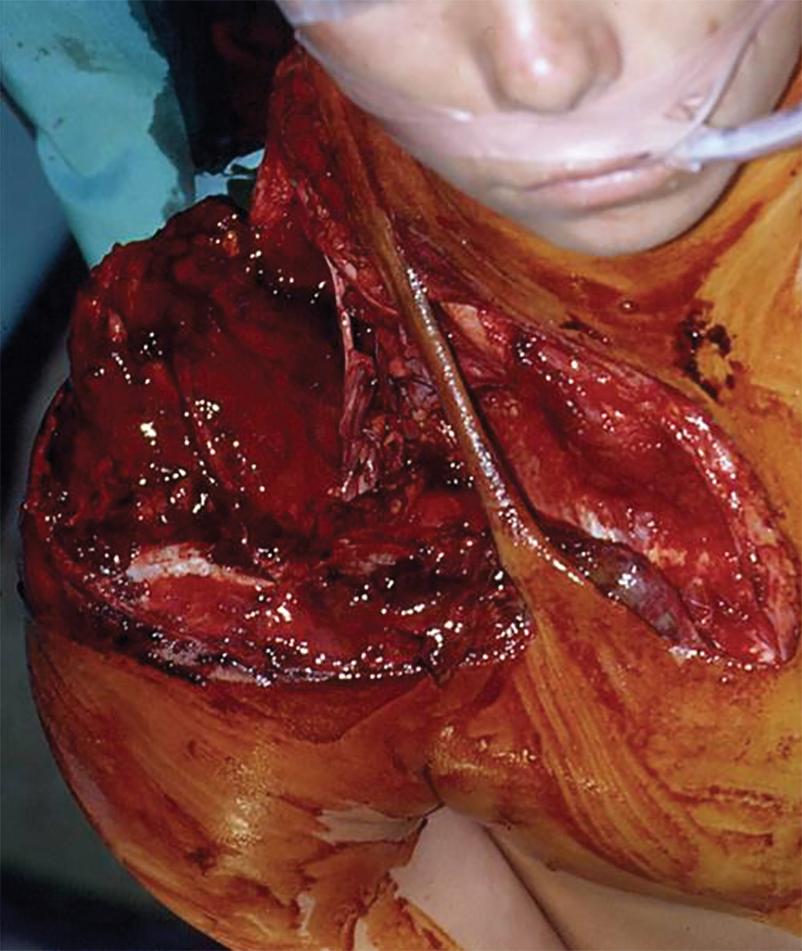
The first report of SD was published in 1984 by Oreck and colleagues. The literature on the topic consists mainly of case reports, small case series, and reviews. Approximately 50% of SD injuries are the result of motorcycle accidents with the remainder of cases resulting from other forms of high-energy trauma including fall from significant height, industrial accidents or blast injuries. A massive traction force to the upper extremity, accompanied by a severe blunt force directed over the shoulder, can lead to a wide array of injury patterns. These include osseous and ligamentous injuries such as clavicle fractures and acromioclavicular and sternoclavicular dislocations, along with soft tissue destruction, which may involve the deltoid, latissimus dorsi, levator scapulae, pectoralis minor, rhomboid, and trapezius muscles. Vascular injuries to the subclavian or axillary vessels and complete or partial avulsion of the brachial plexus are very common and may lead to permanent compromise of the extremity’s functional integrity.
The diagnosis of SD is made on the basis of both clinical findings and radiographic studies. Arriving at a timely diagnosis is crucial to preserve long-term tissue viability and extremity function. This can also be a difficult process, as patients often have severe associated injuries that impede the conduct of complete physical examination or distract the clinician from the involved extremity. The need for intubation, hemodynamic instability, concomitant brain injury, and altered mental status may all delay the diagnosis. Furthermore, intact skin and normal bony anatomy of the arm may be misleading as to the extent of the underlying injury.
Physical findings consistent with SD include massive soft tissue swelling, tenderness to palpation, and gross instability of the involved shoulder. The affected extremity may manifest vascular or neurologic compromise. Vascular injuries may be evidenced by the “six Ps”—pain, pallor, pulselessness, paresthesias, paralysis, and poikilothermia—and have been reported in up to 100% of SD in some series. However, owing to the extensive collateral vascular network around the shoulder, a patient may have subclavian artery occlusion and still have a pulse in the distal extremity with a normal brachial-brachial index. On the other hand, a patient may have a cold, mottled extremity with diminished pulses due to shock or environmental conditions in the absence of a vascular injury. The findings related to vascular and neurologic compromise may overlap. Diagnostic ambiguity calls for further vascular assessment.
The pathognomonic radiographic finding in SD is lateral displacement of the scapula on an anteroposterior chest radiograph ( Fig. 2 ). The degree of displacement may be quantified by the scapula index, which is calculated by measuring the distance from the thoracic vertebral spinous processes to the medial border of the scapula and dividing the distance on the injured side by that on the uninjured side ( Fig. 3 ). It requires an anteroposterior chest radiograph in a supine patient with nonrotated extremities and an uninjured shoulder. In the uninjured population, the scapula index averages 1.07 ± 0.04. Zelle and colleagues reported an average index of 1.29 ± 0.19 in a series of 25 patients with SD, but the diagnostic threshold is not well established. They noted that five of their patients had a scapula index within two standard deviations of the “normal” mean and cautioned that it be used as a screen, but not a definitive diagnostic test.
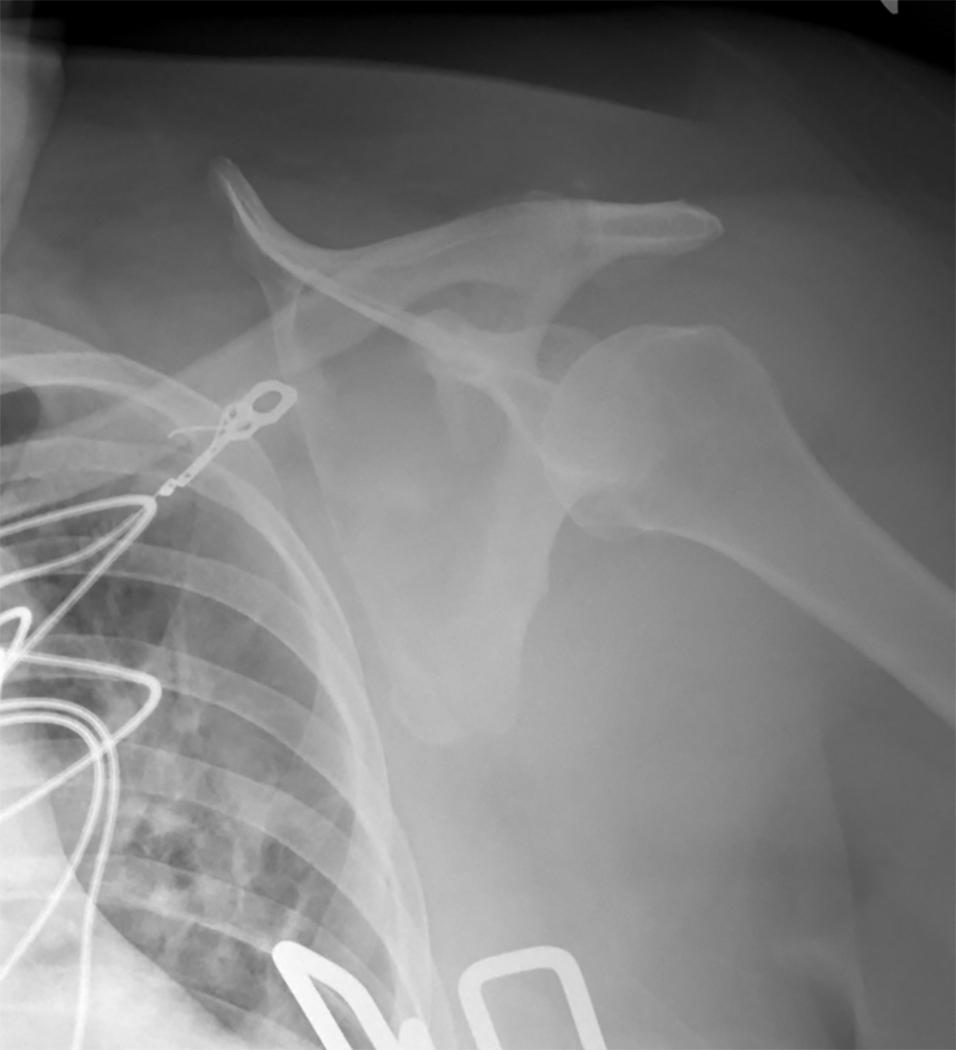
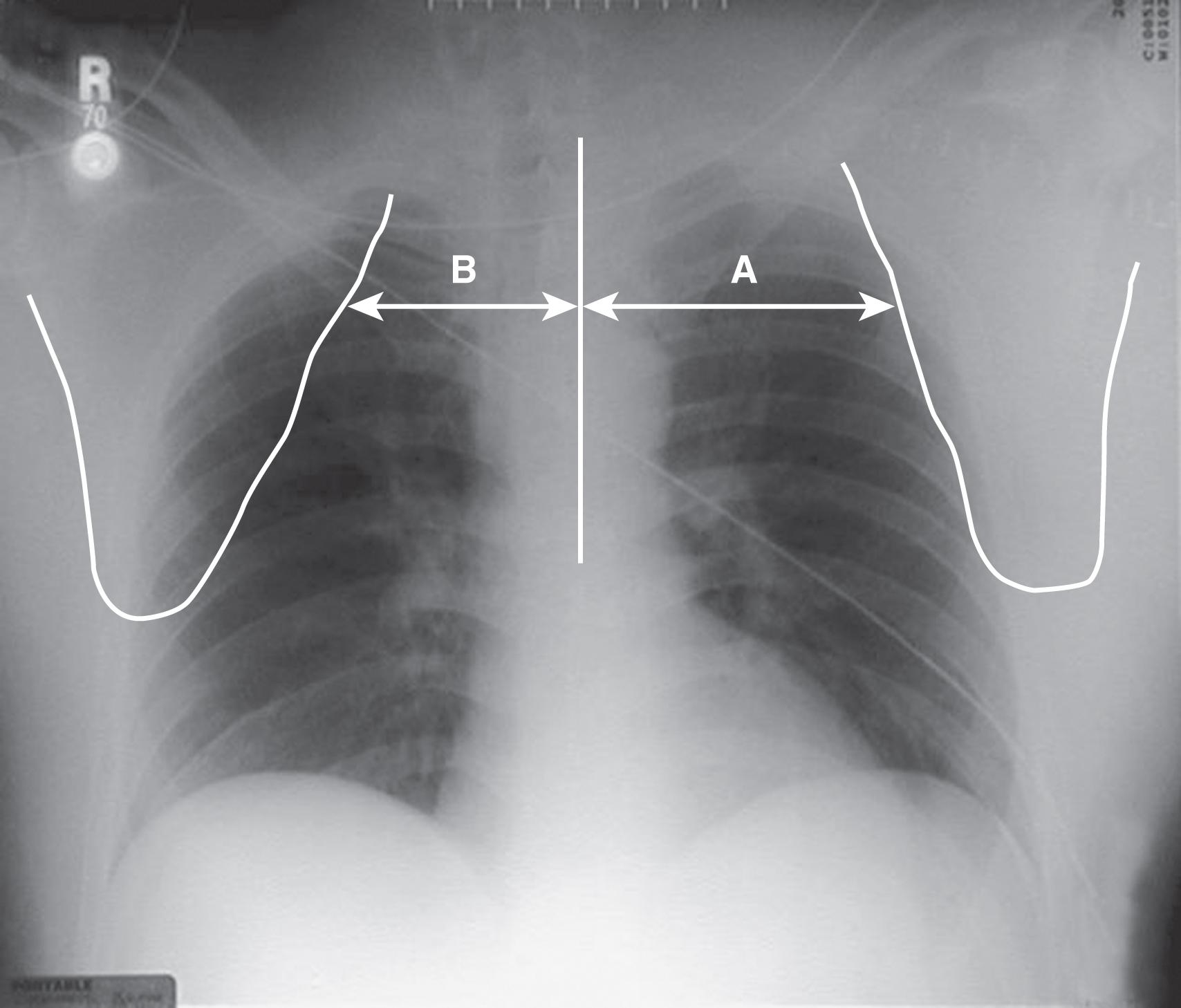
Lange and Noel suggested simply that a difference of greater than 1 cm in the measurements between the injured and uninjured side suggests SD, but Ebraheim and colleagues described alternative measurements from the sternal notch to the coracoid or glenoid margin. Because the accurate measurement of the scapula index requires a standardized radiograph and is affected by patient positioning, it is prudent to look for other clues, such as distracted clavicle fractures and acromioclavicular or sternoclavicular joint disruptions, and to consider the overall clinical picture in determining the possibility of SD.
Associated vascular injuries are very common. In a review of the literature, Damschen and colleagues found that 88% of patients with SD had vascular injuries. More recently, in their large single-institution experience, Zelle and colleagues reported vascular injuries in 16 (64%) of 25 patients. Duplex ultrasonography may be employed to document arterial flow, but arteriography or computed tomographic angiography is indicated in stable patients in whom SD is diagnosed or suspected, as it provides more definitive imaging ( Fig. 4 ). The subclavian, axillary, and brachial arteries should be interrogated.
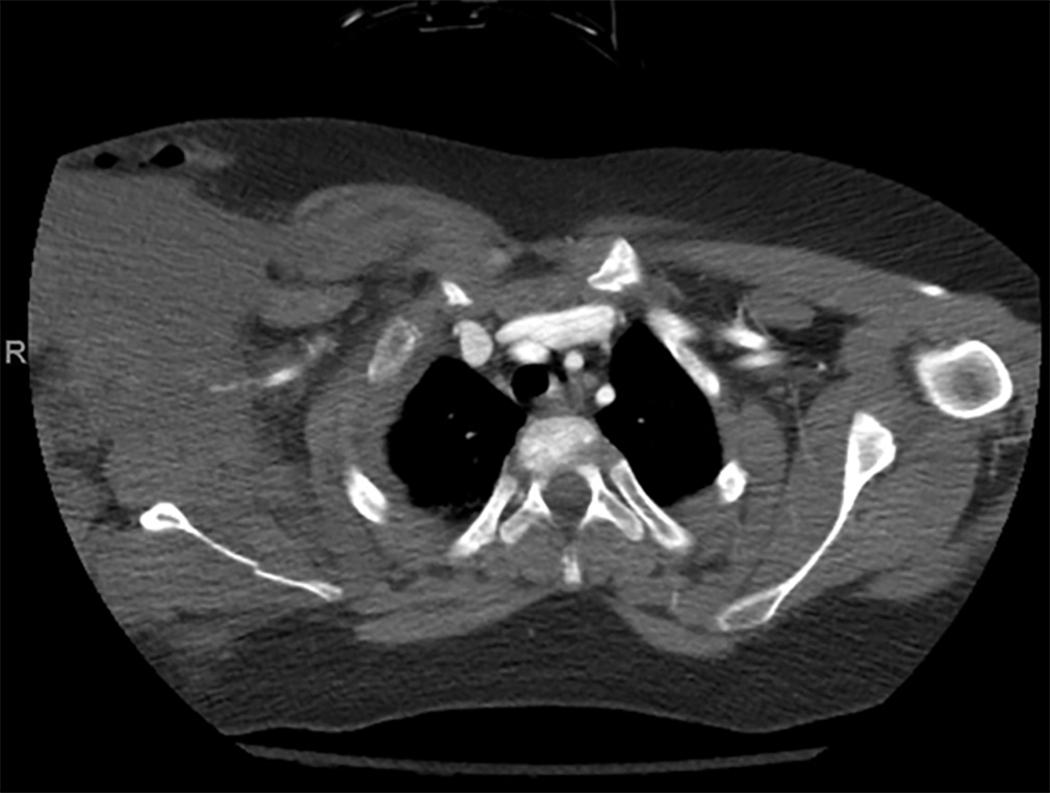
Neurologic injury is also very common with SD. Damschen and colleagues reported from their literature review that 94% of patients had a neurologic injury. In the series of Zelle and colleagues, the incidence was 80%. The precise extent of injury can be difficult to determine initially. Complaints of severe pain in an anesthetic extremity are consistent with nerve root avulsion, but a history and physical examination predict the site of injury in just 30% to 50% of cases. Evidence of concomitant spinal cord injury should be sought when there are any neurologic abnormalities. Computed tomography (CT) scanning and magnetic resonance imaging (MRI) may be complementary in the evaluation of these patients. A CT scan demonstrating paraspinous hematoma would be consistent with nerve root avulsion and suggests that cervical myelography should be performed. The formation of a pseudomeningocele, suggestive of a nerve root avulsion, is best appreciated via CT myelography after paraspinous hematoma resorption 3 to 4 weeks after injury. In the case of incomplete motor deficits, MRI is preferred and, as opposed to a CT myelograph, allows full visualization of the brachial plexus. The T1-weighted images highlight the fat content of the spinal cord and nerve roots; the T2-weighted images highlight the water content and can demonstrate a pseudomeningocele.
Electromyography studies are useful in identifying the involved nerve roots and showing evidence of denervation. Baseline electromyography studies and nerve conduction velocity measurement studies should be ordered 3 to 4 weeks after injury and onset of Wallerian degeneration.
Damschen and colleagues proposed a classification system for SD in 1997 on which to base clinical decision making. In their scheme, musculoskeletal injury alone was classified type I. Type II injuries included vascular (IIA) and neurologic (IIB) injuries. An SD with both vascular and neurologic injuries was called type III. Recently, Zelle and colleagues examined the functional outcomes of 25 patients with SD. Their data demonstrated the pivotal importance of the neurologic injury in determining functional outcome. Consequently, they proposed a modified classification system that introduced a fourth category, type IV, which included all patients with complete brachial plexus avulsions ( Table 1 ).
| Type | Clinical Findings |
|---|---|
| I | Musculoskeletal injury alone |
| IIA | Musculoskeletal injury with vascular disruption |
| IIB | Musculoskeletal injury with incomplete neurologic impairment of the upper extremity |
| III | Musculoskeletal injury with vascular disruption and incomplete neurologic impairment of the upper extremity |
| IV | Musculoskeletal injury with complete brachial plexus avulsion |
Most patients with SD have significant associated injuries, and thus the first step in the management of these patients is initial evaluation and stabilization based on the principles of the Advanced Trauma Life Support course of the American College of Surgeons. Management priorities are established with life-threatening injuries addressed first. Hemodynamically unstable patients who appear to be exsanguinating from vascular injuries should proceed immediately to the operating room for control and repair. Hemodynamically stable patients may undergo a more thorough diagnostic evaluation. If vascular injuries are identified by arteriography or computed tomographic angiography, management is dictated based on the presence of hemorrhage, location of the injury, perfusion of the distal extremity, and neurologic injury. Active hemorrhage must be controlled surgically, unless a branch vessel injury is amenable to angioembolization. Venous injuries may be ligated, but concern for significant upper extremity swelling must always remain. The artery may be reconstructed with a saphenous vein graft or with a polytetrafluoroethylene graft. In the case of an exsanguinating patient, the vessel may be shunted temporarily or ligated. If perfusion is inadequate, this may obligate amputation, but there is often sufficient collateral flow to sustain the extremity. The location of the injury dictates the approach for surgical exposure, proximal and distal control, and the appropriate level of graft interposition. An ischemic extremity must be vascularized within 4 to 6 hours to optimize functional outcome. However, it is well recognized that an arm may be adequately perfused and have a normal brachial-brachial index, even in the case of subclavian artery occlusion, because of the extensive collateral network around the shoulder. In such a case, Sampson and colleagues have suggested a nonoperative approach for hemodynamically stable patients with a viable, well-perfused upper extremity. Clearly, such a treatment course must be individualized. With the growing application of endovascular stents, there is likely a role in stable patients with amenable injuries. Jordan et al published a case report of SD secondary to a severe blast injury and described a novel hybrid approach in which subclavian arterial repair was achieved with deployment of an endovascular graft. Rising use of endovascular technology and availability of hybrid operating rooms likely means the increasing use of such approaches; however, they cannot be recommended as standard of care.
The neurologic injury is a major determinant of outcome and thus of treatment. In patients undergoing surgical exploration for vascular repair, the brachial plexus should be explored. If the brachial plexus is completely avulsed, a primary above-elbow amputation is the preferred initial management, as there is essentially no chance of functional recovery of the extremity. If there is a brachial plexus rupture but the root is not avulsed, repair is appropriate. Primary nerve repair is recommended for sharp penetrating plexus injuries in stable patients. However, in SDs the blunt or stretching-type force momentum dominates. Here tagging of disrupted nerve ends at the time of injury followed by reexploration after 3 to 6 weeks allows for a repair outside of the then-demarcated zone of nerve contusion. In general, nerve reconstruction does not need to be performed as an emergency, but should be performed within 6 months to avoid muscle atrophy and fibrosis and as early as practically possible to minimize the scarring that will make the operation more challenging.
Treatment options for brachial plexus injuries include nerve repair, nerve grafting, neurotization, free functional muscle transfers and tendon transfers, and palliative pain-relieving procedures. Treatment planning is facilitated by CT myelography and electromyography, done at 3 to 4 weeks after injury. Clements and Reisser suggest that nerve repair is indicated if there are fewer than three pseudomeningoceles on CT myelography. On the other hand, the presence of three or more pseudomeningoceles indicates irreparable damage and warrants above-elbow amputation.
The management of the bony injuries is a matter of some controversy. Open reduction and internal fixation may protect vascular repairs as well as facilitate early rehabilitation. There have been no studies to date comparing specific outcomes based on surgical fixation technique. The concept of the shoulder suspensory complex helps determine the need for bony fixation. The complex consists of the scapula, clavicle, and acromioclavicular joint, along with the ligamentous, tendinous, and supporting capsular structures. Small injuries to individual components of the complex may be managed nonoperatively; however, larger or more complex injuries to the complex may result in instability and require repair. Choo et al agree that osseous stabilization between the extremity and the axial skeleton must be achieved, typically through plate and screw fixation. Reconstruction will be heavily dependent on the specific injury and degree of soft tissue disruption. If amputation is indicated, an above-elbow amputation is preferred. Early prosthetic application and rehabilitation are important in optimizing functional outcome.
In the case of open SD, soft tissue coverage is important. Initial wound management consists of débridement of foreign material and necrotic tissue and serial dressing changes. A negative pressure dressing can be useful in facilitating wound care and hastening granulation of the wound bed. Skin grafts may be placed on a clean bed of granulation tissue. If resulting areas of soft tissue deficiency overlie functionally critical areas such as the antecubital or popliteal fossa, or expose structurally important anatomy (bone, tendons, nerves, and vessels), then flap closure is recommended. Consultation with a plastics and reconstructive specialist may aid in optimal soft tissue coverage and reconstruction.
In the early postinjury period, the massive soft tissue injury can result in myoglobinuria, hyperkalemia, and vascular thrombosis. Hydration is important, but the surgeon should be mindful of these risks and be prepared to perform amputation if the patient is compromised. Revascularization of the extremity may be associated with reperfusion injury and development of an extremity compartment syndrome. Thus, serial clinical evaluation of the extremity—with measurement of compartment pressures if there is uncertainty—is essential. These problems may be avoided by early amputation if indicated.
The major morbidity associated with SD is a flail upper extremity. Zelle and colleagues reported that of the 62 well-documented cases of SD in the literature, of 40 patients who survived and did not undergo primary amputation, 24 (60%) were left with a flail extremity. In their experience, all complete brachial plexus avulsions resulted in a functionless extremity. Of seven patients with partial or no avulsion, shoulder function (as assessed by the Subjective Shoulder Rating System) was scored as poor in three, fair in two, and good in two. Long-term deficits were typically related to avulsed nerve roots. Zelle and colleagues argue for early primary amputation in the setting of complete brachial plexus avulsion. It avoids the problems of myoglobinuria, hyperkalemia, and vascular thrombosis. The decision should be made initially in such situations. If early amputation is refused, later amputation should be considered within the first year to improve rehabilitation and functional outcome. Unfortunately, patients and their families often refuse secondary amputation, despite a flail, anesthetic extremity. This can lead to severe causalgia, pressure sores, and injury. Furthermore, the longer the delay from injury to amputation to prosthetic fitting, the less likely the patient is to wear the prosthetic.
The SD-related mortality rate documented in the literature is 11%. However, this may be underestimated, as patients may exsanguinate from uncontrolled subclavian vessel injuries or die of associated injuries without SD being definitively diagnosed.
SD is a rare but devastating injury. Associated injuries are common. The timely diagnosis of vascular and neurologic injuries is critical. The rate of upper extremity loss is high, and many survivors are left with a flail upper extremity. Early amputation is indicated if there is a brachial plexus avulsion. A practical management algorithm, modified from that proposed by Clements and Reisser, is presented in Figure 5 .
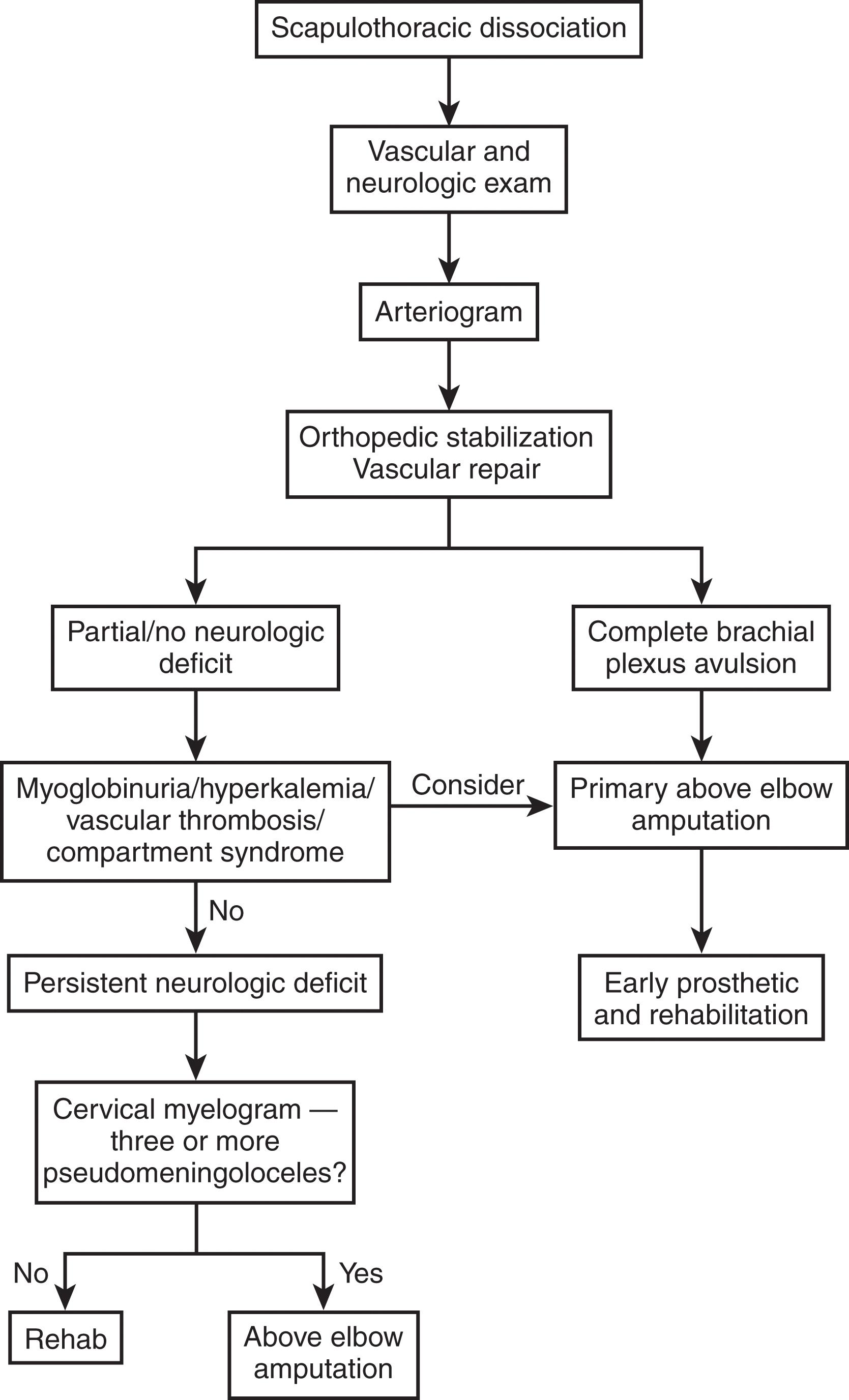
Become a Clinical Tree membership for Full access and enjoy Unlimited articles
If you are a member. Log in here